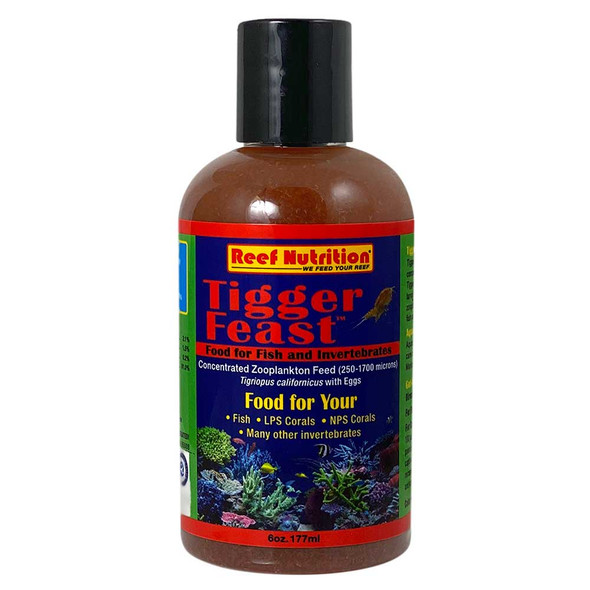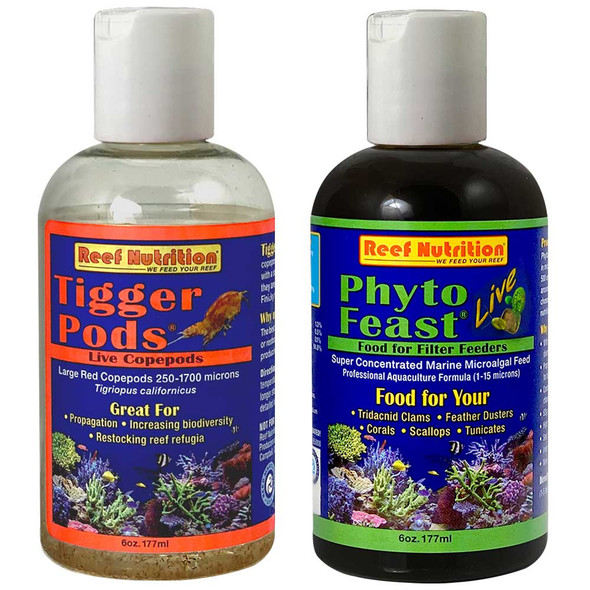Description
Because Tigger-Pods (Tigriopus californicus copepods) swim upwards with a stimulating, jerky motion, they are attractive to a wide range of fish like Mandarin dragonets, Seahorses and Pipefish. They are easy to culture and perfect for propagation or restocking refugia. They breed rapidly, producing scores of eggs per female.
Shipping: Click Here to Learn More about Shipping of Live & Refrigerated Foods from Reef Nutrition
- You won't find any higher quality pods. Tigger-Pods are cultured at Reef Nutrition using a proprietary, meticulous, and bio-secure process by the world leader in the development of algae- and zooplankton-based feeds.
- Your tank will get a big healthy boost because Tigger-Pods are fed on Reef Nutrition Phyto-Feast®—nutritious marine microalgae raised on site.
- Contrary to what some say, Tigger-Pods will thrive in your warm reef tank. In fact, warmer water revs up their metabolism and reproductive rate. They will do well in cool water too.
- Our bottles are the most concentrated on the market, giving your tank more quality pods per dose for your money.
Storage:
We recommend that you add Tigger-Pods the day you receive them. If you need to hold them before adding, simply pop the cap and put them in the fridge for a few days.
Receiving your Tigger-Pods:
Upon arrival, you may notice the Tigger-Pods aren't very active. This is normal when cold shipped or cold stored. As the bottles warm up, the Tigger-Pods will become more active. It is not uncommon to have a few of the oldest copepods to die from old age. We pack the bottle with life stages above 300 microns, so the bottle will be full of juveniles and egg-bearing females. On average, we add at least 10% more in every bottle to account for any DOA. Each bottle contains approximately 3,000 copepods.
Acclimation:
Open bottle cap and remove the inside liner, if there is one. Let the bottle stand at room temp for 2 hours to allow the temperature to rise. The Tigger-Pods can be poured directly into your refugium and/or main tank.
Use:
- Direct feed to fish, corals and other inverts:
- Turn off wavemakers and your recirculating pump(s).
- Pour the animals in and watch the feeding frenzy.
- You can even use a target feeding device for this step.
- Since some of the copepods will cling to the side of the bottle after pouring, make sure to rinse the remainders out with clean saltwater so that you get every last animal.
Establish in a display:
- Turn off the lights, wavemakers and recirculating pump(s).
- Pour the animals in and wait for 30 minutes.
- Return the system to normal function.
Since some of the copepods will cling to the side of the bottle after pouring, make sure to rinse the remainders out with clean saltwater so that you get every last animal.
Establish in a refugium (best method):
- Pour in the animals and watch them settle in.
Since some of the copepods will cling to the side of the bottle after pouring, make sure to rinse the remainders out with clean saltwater so that you get every last animal.
Care and Feeding:
Copepods are relatively easy to care for and maintain. They feed primarily on microalgae and can be fed our phytoplankton-based product blends such as Phyto-Feast.
Copepods can live in your main tank, your refugium, or in a separate dedicated system. In your main tank, they will be eaten and depleted by your fish and corals. In your refugium they will thrive since there are no predators. Pods from your refugium can be periodically harvest and fed to your main tank.
Copepods like to remain inconspicuous, so they will prefer an environment with nooks and crannies. In your main tank they will hide in your live rock and gravel. In your refugium they will hide in your macroalgae and other plants.







